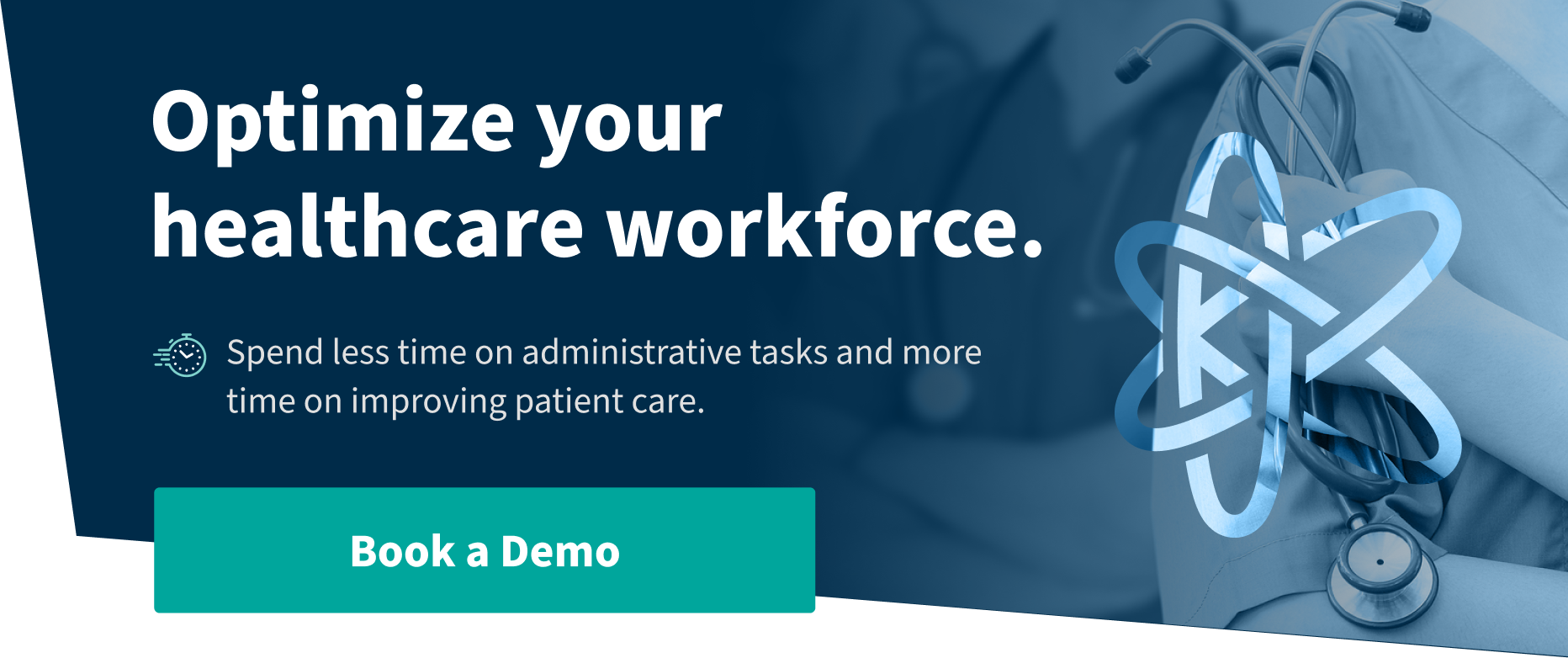In a recent report, the Kimedics team explored the importance of collaborative workforce management to help your healthcare organization to operate more efficiently. Below, we’ll share some of our findings from that report, including three workforce management best practices you should be utilizing to optimize and streamline your operations.
What is Collaborative Workforce Management?
Collaborative workforce management refers to the coordination of multiple internal departments (ops, recruiters, finance, credentialing, etc…). The goal is to optimize workforce utilization, enhance efficiency, ensure accurate information sharing, and provide the best possible patient care.
However, healthcare workforce management faces substantial challenges including outdated practices, siloed systems, duplicated efforts, and communication breakdowns. Issues like outdated rosters, scheduling errors, classification confusion, and dirty data waste time and resources.
To address these pitfalls, here are our top three workforce management best practices:
- Shared Roster Management: Centralize roster information on a shared platform to accelerate hiring and reduce scheduling errors.
- Shared Schedules: Collaborating on digital schedules to fill gaps faster, improve payroll accuracy, and optimize resources.
- Shared Talent: Cross-utilizing talent across the healthcare ecosystem during high-demand situations to increase capacity and retention while reducing costs.
These practices have delivered tremendous impact for our customers by connecting disparate healthcare entities. Let’s break these practices down a little further so that you can improve your own organization’s operations.
Shared Roster Management Helps Align RosterOps Teams
Think of a baseball team. All the players on the team are part of a roster. This roster lists all the players, their jersey numbers, positions they play, and contact information. It helps the coach and managers keep track of who is on the team.
Now imagine if the coach, the managers, and the players all had different homemade rosters. Some might be on paper, some might be drafted in old emails, and some might be typed up in a Google Doc. Now, imagine that everyone's roster has some players missing or wrong information. It would be very confusing!
Shared roster management is fixing this problem by having just one official roster that everyone can view and update. The coaches, managers, players, and even parents can access this one digital roster on their phone or computer.
Whenever someone joins the team or leaves, or a phone number changes, the shared roster is immediately updated so everyone involved has the correct info right away. No more constantly emailing files around or asking over and over "who is our third baseman this week" or “when do we get the new pitcher?”
That's the simple idea behind shared roster management - one official centralized roster that any relevant person can see and rely on for up-to-date team information. It brings everyone onto the same "team"!
For healthcare organizations like yours, shared roster management refers to collaborating across the many entities you might be working or partnering with to maintain up-to-date provider information on a centralized platform. When RosterOps teams are aligned, it eliminates duplicate data entry and provides real-time visibility into roster details.
Specifically, medical groups and hospitals are sharing provider rosters with staffing agencies and other partners through our product's cloud-based system. This gives all relevant parties access to the same accurate hiring and credentialing statuses, assignments, and due dates.
There are several benefits of this collaborative roster approach. These include, but aren’t limited to:
- Faster Candidate Submissions: Centralized provider profiles accelerate the submission process by eliminating duplicate name clearing and information gathering.
- Reduction in Scheduling Errors: Direct access to the latest provider credentials and availability enables more accurate and efficient scheduling.
- Time Savings: Shared rosters replace disjointed tracking through emails, calls, and spreadsheets with outdated information. All details in one place streamline the workflow.
Assume for a moment you’re managing more than 3,000 physicians. It can be incredibly time consuming to double check all the credentials of every person on your roster, let alone confirm you have the correct contact information and pay rates for everyone. However, if you have a shared roster system, you can dramatically enhance efficiency, speed, and accuracy in physician and nurse hiring and scheduling.
Shared Schedules
Our next best practice based on our research is developing shared schedules across healthcare entities. This involves collaborating to map provider availability and assignments digitally across multiple locations and systems.
The major benefits of shared schedules are:
- Reduction in Time to Source Availability: With real-time visibility into openings across groups, filling gaps through internal transfers or external staffing partners is expedited.
- Improvement in Payroll Accuracy: Incorporating rates and statuses from various systems into consolidated schedules enhances payroll precision.
Related: Click here and learn how Kimedics can help reduce payroll corrections thanks to centralized rate information and automated workflow approvals.
- Reduction in Schedule Gaps: Efficient collaboration to broadcast schedule needs and availability of internal float pool and external contingent talent leads to rapid fill rates and continuity of care.
The complexity of modern healthcare means physicians increasingly work across multiple hospital systems, while providers and nurses may handle shifts at several locations. Keeping schedules straight can be a nightmare of logged emails and endless games of phone tag. Hospital A doesn't know Doctor B also works weekends at Hospital C or that those shifts may overlap.
Our workforce relationship management software provides a shared scheduling platform that seamlessly aligns provider availability across healthcare groups. If you need extra support on any given day, with a few clicks, your healthcare organization can access up-to-date schedules and immediately identify which providers are available to cover shifts.
No more flooded inboxes and headaches around trying to coordinate coverage. All providers can see and confirm the open shifts on his/her schedule. Our platform automatically syncs credentialing, payroll rates, and health system data so there are no questions or issues at any point in the workflow.
This simplified scheduling fluidity underpins true healthcare collaboration. Finding and managing provider coverage is made easier than ever across previously siloed organizations. The result is that healthcare administrative workforce efficiency is unlocked.
Shared Talent
The final of our workforce management best practices is shared talent. Put another way, this practice in collaborative workforce management is cross-utilizing and collaborating on provider talent across different healthcare entities. This model of shared talent enhances capacity, retention, and distribution.
The major benefits of shared talent are:
- Increase in Roster Capacity: Cross-credentialing and collaboration during high-demand situations like the pandemic enabled rapid capacity expansion to save more lives.
- Stronger Physician Retention and Satisfaction: The ability to access more work opportunities through affiliations with other groups improved provider job satisfaction and income stability during uncertain times.
- Reduction in Premium Labor Spend: Getting existing providers credentialed quickly across different locations reduces reliance on expensive temporary labor.
Related: Learn how Kimedics can help you reduce premium labor spend.
- Better Distribution of Work: Aligning provider capacity and patient volume through interdepartmental and inter-organizational coordination ensures optimal workload distribution and care quality.
To better explain the importance of shared talent, here’s a brief look at the example we gave in our Best Practices in Collaborative Workforce Management Case Study:
During the initial COVID-19 outbreak, rapid collaboration occurred across states to meet surging critical care needs. Anesthesia groups supplemented ICU demand by credentialing providers to intensive care while surgery cancellations freed up capacity. This agile response was only possible through a shared workforce approach.
Such interoperability delivers continuity of care at reduced costs during disruptions. As healthcare grows more interconnected, managing providers collaboratively is essential for organizational and systemic resilience.
The Future of Healthcare is Collaborative
The complexity of modern healthcare requires a coordinated effort to optimize scarce resources while ensuring care continuity. As seen during recent disruptions, decentralized systems fail under pressure leading to burnout, errors, delays, and barriers to care access.
However, by embracing the three best practices of shared roster management, shared scheduling, and shared talent, healthcare groups can transform operations. Collaborative workforce management via shared platforms improves communication, transparency, agility, and system integration.
Our workforce management platform enables frictionless coordination across medical groups, hospitals, staffing agencies, and providers. By centralizing data, automating workflows, providing universal analytics, and delivering omnichannel accessibility, it drives the future of healthcare workforce management.
Just a few of the features you will enjoy when you start working with Kimedics are:
- Shared Access and Visibility: The system centralizes roster, scheduling, compliance and credentialing data with access controls for different entities. This enables seamless collaboration with comprehensive insight.
- Automated Workflows: Rules-based automation around hiring, onboarding, time tracking, approvals, and other workflows smooths process interoperability across groups.
- Universal Tracking: Customized reporting and real-time tracking provide system-wide transparency for workforce KPIs including capacity, utilization, and spend analytics.
- Omnichannel Connectivity: Integrations, payroll interfaces, and accessibility across desktop and mobile facilitate seamless provider experience across multiple affiliations.
These functionalities barely scratch the surface of all the ways Kimedics can help organizations like yours streamline end-to-end workforce coordination while optimizing costs and outcomes.
The time has come for healthcare to move beyond fragmentation and rally behind connectivity. This will prepare the industry not just to endure unexpected crises but also to accelerate innovation and growth during stability. What patients need most is accessible, affordable and high-quality care through a responsive, resilient healthcare system. Collaborative workforce management makes that vision possible.
Want to learn more about what Kimedics can do for you? Click here to schedule a free demo now!


